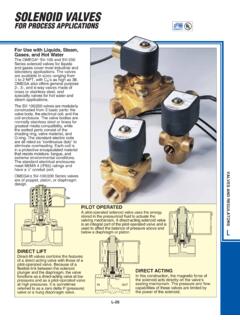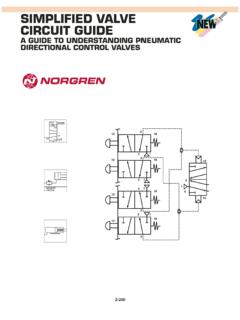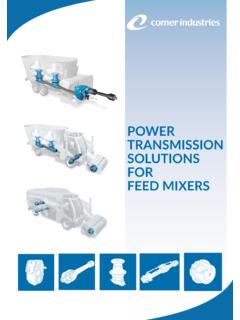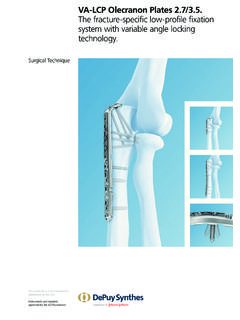Transcription of STRAIN GAUGE INSTALLATION - OMEGA
1 E-12 ESTRAIN GAGESSTRAIN GAUGE INSTALLATIONHOW TO POSITION STRAIN GAUGES TO MONITORBENDING, AXIAL, SHEAR, AND TORSIONAL LOADS STRAIN is defined as the ratio of thechange in length to the initialunstressed reference length. A straingauge is the element that senses thischange and converts it into anelectrical signal. This can beaccomplished because a straingauge changes resistance as it isstretched, or compressed, similar towire. For example, when wire isstretched, its cross-sectional areadecreases; therefore, its important factors that must beconsidered before selecting a straingauge are the direction, type, andresolution of the STRAIN you wish measure minute strains, the usermust be able to measure minuteresistance changes. The WheatstoneBridge configuration, shown inFigure B, is capable of measuringthese small resistance the signs associated with eachgauge numbered 1 through 4.
2 Thetotal STRAIN is always the sum of thefour strains. The total STRAIN isrepresented by a change in each GAUGE had the same positivestrain, the total would be zero and VOUT would remain unchanged. Bending,axial, and shear STRAIN are the mostcommon types of STRAIN actual arrangement of your straingauges will determine the type ofstrain you can measure and theoutput voltage change. See FiguresC through example, if a positive (tensile) STRAIN is applied to gauges 1 and 3,and a negative (compressive) strainto gauges 2 and 4, the total strainwould be 4 times the STRAIN on onegauge. See Figure total STRAIN is fourtimes the STRAIN onone GAUGE , thismeans that theoutput will be fourtimes , greatersensitivity andresolution arepossible whenmore than onestrain GAUGE followingequations showthe relationshipsamong stress, STRAIN , and force forbending, axial, shear, and )BENDING STRAINor momentstrain is equal to bending stressdivided by Young s Modulus ofElasticity.
3 B=oB/E oB=MB/Z = F (l)/ZMoment stress (oB) equalsbending moment (F xl) dividedby sectional modulus. Sectionalmodulus (Z) is a property of thecross-sectional configuration of thespecimen. For rectangles only, thesectional modulus is (bh2/6). Straingauges used in the bending strainconfiguration can be used todetermine vertical load (F ); thisis more commonly referred to asa bending beam load =E B(Z)/l=E B(bh2 6)/l2)AXIAL STRAIN equals axialstress divided by Young sModulus. A=oA/E oA=FA/AWhere axial stress (oA) equalsthe axial load divided by thecross-sectional area. The cross-sectional area for rectanglesequals (b x d). Therefore, straingauges used in axialconfigurations can be used todetermine axial loads (F (axial)).F(axial)=E Abh3)SHEAR STRAIN equals shearstress divided by modulus ofshear stress. = /G =F x Q/bIWhere shear stress ( ) equals(Q), the moment of area aboutthe neutral axis multiplied by thevertical load (F ) divided by thethickness (b) and the moment ofinertia (I).
4 Both the moment ofarea (Q) and the moment ofINREGULATEDDCV1 OUTV234 + ++ Sig- Sig- Exc+ ExcFig. BWheatstone BridgeFigure C - Bending StrainFigure D - Axial StrainFigure E - Shear StrainFigure F - Torsional Strain31Fv2L4bh31FA24bh31Fv2454bh31MT245 4ZL454545 YZYE-13 STRAIN GAUGE INSTALLATIONHOW TO POSITION STRAIN GAUGES TO MONITORBENDING, AXIAL, SHEAR, AND TORSIONAL LOADS inertia (I) are functions of thespecimen s rectangles onlyQ=bh2 8and I = bh3 12 The shear STRAIN ( )isdetermined by measuring thestrain at a 45 angle, as shown inFigure E. =2X @45 The modulus of shear STRAIN (G) =E/2 (1 + ). Therefore, straingauges used in a shear strainconfiguration can be used todetermine vertical loads (F ); thisis more commonly referred to asa shear beam load =G( ) bI/Q=G( )b(bh3 12)/(bh2 8)=G( )bh(2/3)4)TORSIONAL STRAIN equalstorsional stress ( ) divided bytorsional modulus of elasticity (G).
5 See Figure F. =2x @ 45 = /G =Mt(d/2)/Jwhere torsional stress ( ) equalstorque (Mt) multiplied by thedistance from the center of thesection to the outer fiber (d/2),divided by (J), the polar momentof inertia. The polar moment ofinertia is a function of the cross-sectional area. For solid circularshafts only, J = (d)4 32. Themodulus of shear STRAIN (G) hasbeen defined in the precedingdiscussion on shear stress. Straingages can be used to determinetorsional moments as shown inthe equation below. Thisrepresents the principle behindevery torque (J) (2/d)= G (J) (2/d)= G( d3 16) =MTL/G(J)The following table shows how bridgeconfiguration affects output,temperature compensation, andcompensation of superimposedstrains. This table was created usinga GAUGE factor of , Poisson sRatio of , and it disregards thelead wire chart is quite useful indetermining the meter sensitivityrequired to read STRAIN compensation isachieved in many of the aboveconfigurations.
6 Temperaturecompensation means that thegauge s thermal expansioncoefficient does not have to matchthe specimen s thermal expansioncoefficient; therefore, any OMEGA STRAIN GAUGE , regardless of itstemperature characteristics, can beused with any specimen bridges can havetemperature compensation if adummy GAUGE is used. A dummygauge is a STRAIN gage used in placeof a fixed resistor. Temperaturecompensation is achieved when thisdummy GAUGE is mounted on a pieceof material similar to the specimenwhich undergoes the sametemperature changes as does thespecimen, but which is not exposedto the same STRAIN . Straintemperature compensation is not thesame as load (stress) temperaturecompensation, because Young'sModulus of Elasticity varies SENSITIVITY OUTPUT PERBRIDGE OF GAGES mV/V @ @ 10 VTEMP SUPERIMPOSEDSTRAINTYPEFIG. C-F1000 EXCITATION COMP. STRAIN COMPENSATED1 V/ NoNone1 21, V/ V/ YesAxial1 V/ NoNone1 21, V/ YesNone1 21, V/ V/ YesBending1 21, V/ YesAxial and Bending@ 45 V/ YesAxial and Bending@ 45 FE-14 ESTRAIN GAGES 1= STRAIN in GAUGE 1 p,q = Principal strains 2= STRAIN in GAUGE 2 p,q = Principal stresses 3= STRAIN in GAUGE 3 p,q = the acute angle from the axis of GAUGE 1 to the nearest principal = Modulus of elasticityWhen positive,the direction is the same as that of the GAUGE = Poission s Rationumbering and, when negative, opposite.
7 = 2 VrGF[( +1) Vr( 1)] = 2 VrGF( +1) = VrGFFull-Bridge Configurations(BENDING)BIAXIAL STRESS STATE EQUATIONS (X-Y)ROSETTE EQUATIONSR ectangular Rosette: 0/45/90 x= X yEE y= y xEE z= X yEE x=E( x+ y)1- 2 y=E( x+ x)1- 2 z=0 p,q=12[] p,q=E2[] p,q=1 TAN-12 2 1 32 1 3 p,q=13[] p,q=E3[] p,q=1 TAN-13( 2 3)22 1 2 3 1+ 2+ 3 11 1+ 1+ 3 11 1+ 1+ 3 ( 1 3)2+(2 2 1 3)2 ( 1 3)2+(2 2 1 3)2 2[( 1 2)2+( 2 3)2+( 3 1)2] 2[( 1 2)2+( 2 3)2+( 3 1)2] 1+ 2+ 3 23123145 45 60 60 (AXIAL) STRAIN GAUGE INSTALLATIONSTRAIN BRIDGE DIAGRAMS AND EQUATIONSEQUATIONSSGD-3/120-RYT21, shownlarger than actual page E-27 SGD-3/120-RY41, shownlarger than actual page E-26 Delta Rosette: 0/45/90 Where: GAUGE position on RosetteGauge position on Rosette)UHHSKRQH _,QWHUQDWLRQDO _)D[ _6 DOHV#RPHJD FR XNZZZ RPHJD FR XNMore than 100,000 Products Available!&$1$'$ZZZ RPHJD FD/DYDO 4 XHEHF 7& 20(*$*(50$1<ZZZ RPHJD GH'HFNHQSIURQQ *HUPDQ\ )5$1&(ZZZ RPHJD IU %(1(/8.))]
8 ZZZ RPHJD QO 7 HPSHUDWXUHC alibrators, Connectors, General Test and MeasurementInstruments, Handheld Instruments for TemperatureMeasurement, Ice Point References, Indicating Labels,Crayons, Cements and Lacquers, Infrared TemperatureMeasurement Instruments, Recorders, Relative HumidityMeasurement Instruments, PT100 Probes, PT100 Elements,Temperature & Process Meters, Timers and Counters,Temperature and Process Controllers and Power SwitchingDevices, Thermistor Elements, Probes and Assemblies,Thermocouples, Thermowells and Head and WellAssemblies, Transmitters, Thermocouple Wire, RTD Probes3 UHVVXUH 6 WUDLQ DQG )RUFHD isplacement Transducers, Dynamic Measurement ForceSensors, Instrumentation for Pressure and StrainMeasurements, Load Cells, Pressure Gauges, PressureReference Section, Pressure Switches, Pressure Transducers,Proximity Transducers, Regulators, Pressure Transmitters, STRAIN Gauges, Torque Transducers, ValvesS+ DQG &RQGXFWLYLW\Conductivity Instrumentation, Dissolved OxygenInstrumentation, Environmental Instrumentation, pHElectrodes and Instruments, Water and Soil AnalysisInstrumentation+HDWHUVBand Heaters, Cartridge Heaters, Circulation Heaters,Comfort Heaters, Controllers, Meters and SwitchingDevices, Flexible Heaters, General Test and MeasurementInstruments, Heater Hook-up Wire, Heating CableSystems, Immersion Heaters, Process Air and Duct,Heaters, Radiant Heaters, Strip Heaters, Tubular Heaters)
9 ORZ DQG /HYHOAir Velocity Indicators, Doppler Flowmeters, LevelMeasurement, Magnetic Flowmeters, Mass Flowmeters,Pitot Tubes, Pumps, Rotameters, Turbine and Paddle WheelFlowmeters, Ultrasonic Flowmeters, Valves, Variable AreaFlowmeters, Vortex Shedding Flowmeters'DWD $FTXLVLWLRQC ommunication Products and Converters, DataAcquisition and Analysis Software, Data LoggersPlug-in Cards, Signal Conditioners, USB, RS232, RS485,and Parallel Port Data Acquisition Systems,Transmitters and Receivers81,7(' 67$7(6 ZZZ RPHJD FRP 7& 20(*$6 WDPIRUG &7 81,7(' .,1*'20 ZZZ RPHJD FR XN0 DQFKHVWHU (QJODQG EhernetWireless)))))











